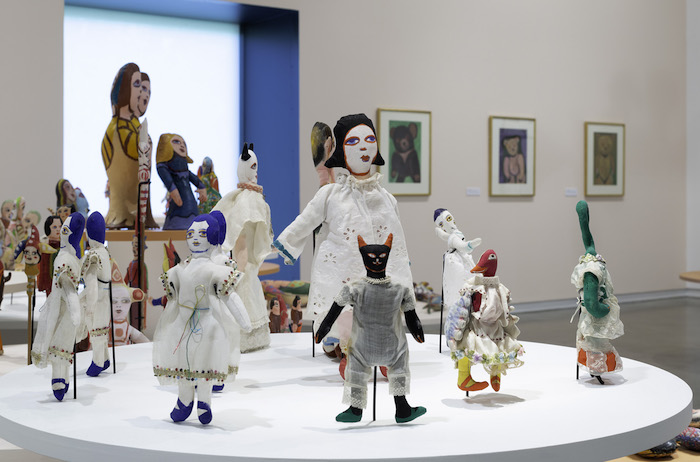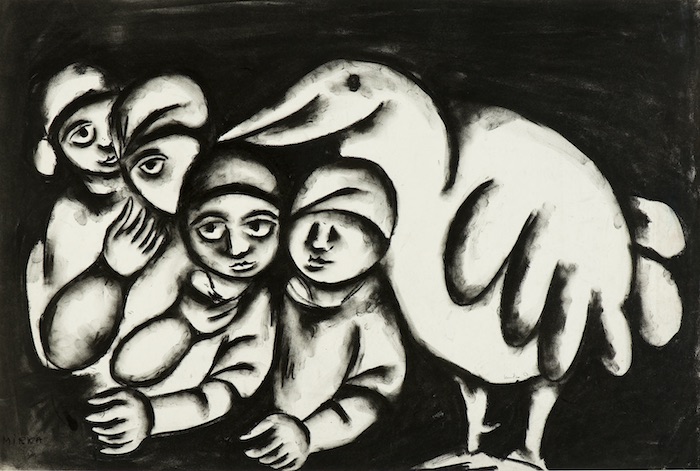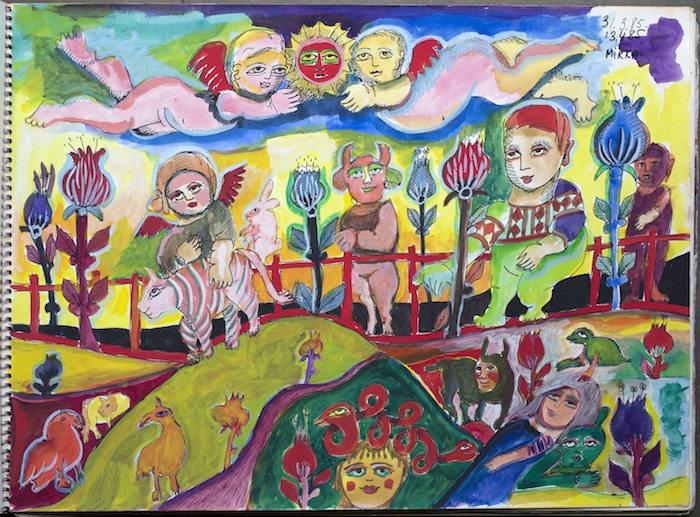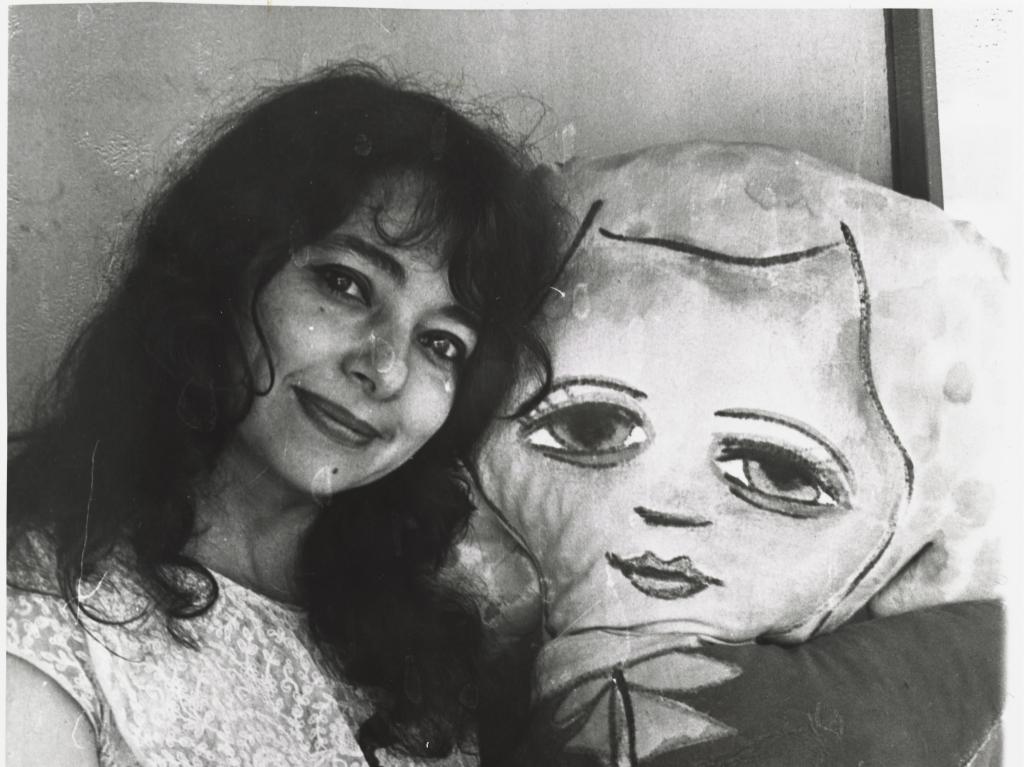Mirka Mora c.1973, gelatin silver photograph 22 x 17 cm (detail). Photographer unknown. Herald & Weekly Times Limited portrait collection State Library Victoria, Melbourne © Herald & Weekly Times Limited.
How do you arrange over 400 objects from a prolific artist’s personal collection of drawings, sketches, invitations, notebooks, ceramic tiles and dishes, paintings, paper dolls and soft dolls and give them individual justice as well as their place in a narrative of a long and compulsively creative life?
That was the challenge for curators Lesley Harding and Kendrah Morgan, who were limited to four display spaces, with another two given to an interactive space and a screening room.
As a viewer you are guided by the invisible hands of the curators. As you step into the exhibition space you are met by a photo of the artist cuddling a life-sized soft sculpture doll, as if they were the best of friends or two parts of the one person. Either way, the image contains the point of the exhibition with the caption, Mirka Mora, Pas de Deux, Drawings and Dolls. For her there is no distinction. The dolls are her drawings in three-dimensions, and as alive as herself.

Installation view, Mirka Mora: Pas de Deux—Drawings and Dolls, 2018, Heide Museum of Modern Art, photograph: Christian Cappuro.
Turning left, you enter the first space, which is a survey of her early work and most of it private and personal, such as drawings and text as birthday and Christmas greetings. Here also are the genesis of some of the themes and forms that she would take with her for the rest of her creative life. One, Les Enfants Qui S’Aiment, Pour Sunday, an image of a boy and girl with rainbow hair and angels’ wings holding flowers, captures the feel of so much of her work to follow. Done in 1958 with fibre-tipped pen, brush and coloured inks on paper, this was a sweet gift for Sunday Reed, her patron and friend. A pen and ink and watercolour, Silence! La queue du chat balance completed in 1961, ten years after Mora arrived in Melbourne from Paris, contains black and white with colour in a tableau of animal creatures and packs of huddled peasant girls with an angel ascendant. This is a space that could take a good hour of viewing and leave you enriched and refreshed, yet barely two decades into her career and with so much more to come.
Follow your nose to the next space, a vibrant panorama of colour with display cases laid out like a feast with sketchbooks, drawings, paper dolls, exhibition invitations and hand-painted ceramic tiles and dishes. On the walls are some extraordinary works that are entirely hers but have hints of Picasso in the erotic Animal Love and Untitled (For Don & Genevieve, with love – true love) from 1973-74, and similarly in an open sketchbook black and white drawing of standing minotaurs with erect animal penises. But the diversity and delicacy of the drawings defy category and belong separately as entries in a fantastical dictionary of her own iconography. These aren’t conscious creations. ‘I have to listen to my hand’, Mora is quoted on the wall note. ‘The drawing comes before I know it’.

Mirka Mora Bird with Brood 1958, charcoal on paper 49 x 76 cm. Courtesy William Mora Galleries, Melbourne © Estate of Mirka Mora.
From such abundance and fecundity, the eye is drawn to a dark room, painted perhaps in deep plum. The work here is black and white, mostly charcoal, and intensely felt. Here is the flip side of the exuberant artist; here is the other step in the dance. The emotional impact of this room is deep and powerful. Mora proves herself a master of the economy of line to extract the maximum effect from a minimum of effort. Her Eastern European heritage shadows these works, which seem to speak from the depths of her soul. Bird with Brood, a charcoal on paper from 1960, is a family portrait that could only have come from that tradition. Although there are no more than 20 works on the walls, a resting bench invites the viewer to sit and take the time to absorb the weight of experience in these sublime pieces.
To lighten the mood, we move from the dolorous to the dolls, mostly soft, some in plaster, over 200 of them, on tables, in corners, on shelves, resting, standing, suspended from the ceiling, populating a realm of dreams and fictions, the true children of imagination. Half of the whole exhibition is in wild freedom in this space, which is the fourth and last of the works on display.
To one side is the interactive room, where viewers are invited to Make Your Own Mirka Creature and place it in the doll’s house in outline on a wall or to take home. That room was as prolific as the artist herself, and on the other side is a viewing room, where we see the person not the artist, as a baby, a child, a daughter, a sister, a teen, a mother. This is the perfect note to finish the exhibition, bringing us to the artist as the artist has brought herself to us.

Mirka Mora Untitled (sketchbook page) 1985, fibre-tipped pen and gouache on paper. Courtesy William Mora Galleries, Melbourne © Estate of Mirka Mora.
This exhibition brings us the Mirka Mora we have always known but never seen. It’s an open door to her home and studio and it’s an insight into her personal psychology. It is but a small measure of how prolific Mirka Mora was, who seemed to have found breathing and creating to be one and the same thing. It offers us an entirely original artist who, now in heaven, may find herself gravitating to William Blake and Marc Chagall and Maurice Sendak for company.
Conceived as a celebration of 90 years of vital living, and turning into a tribute to a singular and spectacular life, this exhibition has a flow that takes us to all parts of the artist’s heart in a line as effortless as Mirka Mora’s own.
Rating: 4 ½ stars ★★★★☆
Mirka Mora: Pas de Deux—Drawings and Dolls
Curators Lesley Harding and Kendrah Morgan
27 October 2018 – 24 March 2019
Heide Museum of Modern Art, Melbourne





